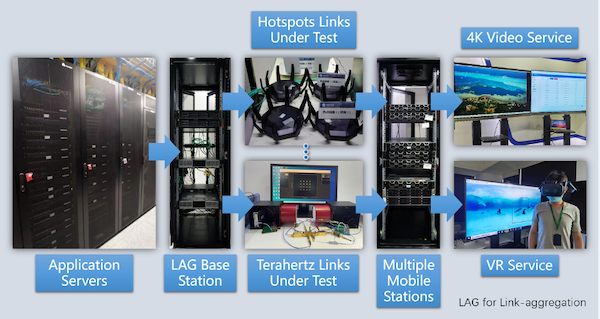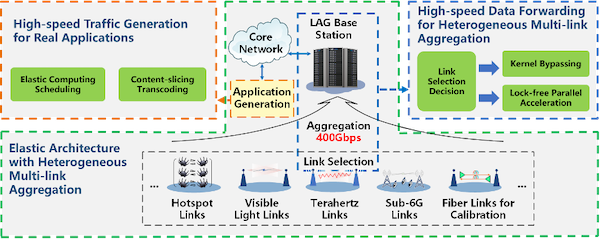
- Home
- Media Center
-
Events
- Wuzhen Summit
- Regional Forums
- Practice Cases of Jointly Building a Community with a Shared Future in Cyberspace
- World Internet Conference Awards for Pioneering Science and Technology
- The Light of Internet Expo
- Straight to Wuzhen Competition
- Global Youth Leadership Program
- WIC Distinguished Contribution Award
- Membership
- Research & Cooperation
- Digital Academy
-
Reports
- Collection of cases on Jointly Building a Community with a Shared Future in Cyberspace
- Collection of Shortlisted Achievements of World Internet Conference Awards for Pioneering Science and Technology
- Reports on Artificial Intelligence
- Reports on Cross—Border E—Commerce
- Reports on Data
- Outcomes of Think Tank Cooperation Program
- Series on Sovereignty in Cyberspace Theory and Practice
- Other Achievements
- About WIC
- 中文 | EN

Collection: EAGLE 6G - An original prototype and evaluation environment for enhanced broadband 6g

Peng Cheng Laboratory, together with Beijing University of Posts and Telecommunications, Huazhong University of Science and Technology, and University of Electronic Science and Technology of China, has developed EAGLE 6G (Elastic multi-AGgregated-Link Environment for 6G), an original prototype and evaluation environment for enhanced broadband 6G, which enables 6G innovative technology evaluation and testing for both academic and industry, laying the foundation for future technological innovation and standardization of 6G technologies.
To overcome the challenges of serving future 6G high data-rate applications, including supporting highly dynamic data rates, efficiently aggregating heterogeneous links, and generating high enough data-rate testing flow for wireless applications, the EAGLE 6G research team has developed an original prototype and evaluation environment for enhanced broadband 6G.
A key objective of the EAGLE 6G project was to address three challenges associated with 6G high data-rate applications (100Gbps, 100 times greater than commercial 5G in capacity), including the ability to support highly dynamic data rates, efficiently aggregate heterogeneous links, and generate a sufficient flow of data-rate testing for wireless applications. The EAGLE 6G architecture is proposed, and a prototype and evaluation environment is released that can support dynamic aggregation of heterogeneous links, such as high-speed hotspots, visible light, terahertz, etc., and even optical fiber calibration links. Based on theoretical analysis, the proposed architecture can significantly improve system coverage and capacity performance by aggregating high data-rate links efficiently. Through the use of kernel bypassing and lock-free parallel acceleration techniques, EAGLE 6G is capable of supporting heterogeneous aggregation of 400Gbps rates. Furthermore, the project can generate hundreds of Gbps of flows for service testing, and eventually develop an evaluation environment that can support tests of 100Gbps for a single service flow and 400Gbps for multiple service flows.

The System Architecture of EAGLE 6G
Aiming at the future 6G standardization, EAGLE 6G enables evaluation and testing for 6G innovative technology research, global standardization, and industry-university-research cooperation.
The EAGLE 6G provides a high-speed wireless communication testing environment for technologies related to 6G, such as terahertz, visible light, and millimeter-wave. Furthermore, it will be able to provide innovative technology testing services for 6G to scientific research institutes, universities, device manufacturers, and operators and enhance the 6G innovation ecosystem. As a result of this project, the research team has published more than 20 high-impact journal and conference papers, received several best (student) paper awards, and has been granted more than 40 patents.

Part of the Awards, Published Papers, and Authorized Patents Based on EAGLE 6G.
EAGLE 6G has provided tests for potential key technologies of 6G, such as millimeter-wave and terahertz links, and will keep facilitating the evaluation and standardization for 6G promising technologies, as well as empowering the 6G innovation ecosystem.
Through evaluating and standardizing 6G promising technologies, EAGLE 6G has demonstrated the feasibility of ultra-high-speed mobile access networking at a Tbps-level in the 6G era by demonstrating dynamic heterogeneous link aggregation, high-speed traffic forwarding, and high-speed traffic generation for real applications. The development of strategic emerging industries and the promotion of economic and social development can be further advanced by providing a universal testing platform for evaluating 6G promising technologies and emerging applications.

The World Internet Conference (WIC) was established as an international organization on July 12, 2022, headquartered in Beijing, China. It was jointly initiated by Global System for Mobile Communication Association (GSMA), National Computer Network Emergency Response Technical Team/Coordination Center of China (CNCERT), China Internet Network Information Center (CNNIC), Alibaba Group, Tencent, and Zhijiang Lab.





